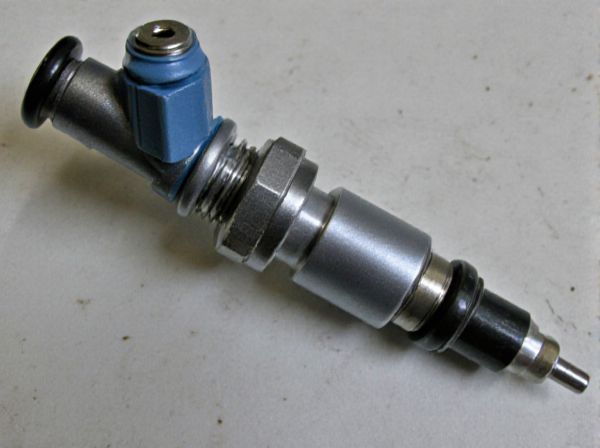
Photo illustration: Fixed Orifice Injector vs Variable Orifice Injector
Fixed orifice injectors provide a constant flow rate due to their unchanging nozzle diameter, ensuring simplicity and reliability in fuel delivery systems. Variable orifice injectors adjust the orifice size dynamically, allowing for more precise control of fuel flow based on engine demand, improving efficiency and performance. Your choice depends on whether you prioritize straightforward operation or enhanced adaptability in fuel injection.
Table of Comparison
| Feature | Fixed Orifice Injector | Variable Orifice Injector |
|---|---|---|
| Orifice Size | Constant size | Adjustable size |
| Fuel Flow Control | Limited | Precise, adaptive |
| Fuel Efficiency | Lower | Higher |
| Performance | Stable, less flexible | Enhanced, optimized |
| Emissions | Higher emissions | Reduced emissions |
| Complexity | Simple design | More complex mechanism |
| Cost | Lower initial cost | Higher initial cost |
| Application | Basic engines | Advanced engines |
Introduction to Fuel Injectors
Fuel injectors play a crucial role in delivering precise fuel amounts to an engine's combustion chamber. Fixed orifice injectors have a constant diameter opening that limits fuel flow based on pressure, offering simplicity and reliability but less adaptability to varying engine demands. Variable orifice injectors adjust the size of the opening dynamically, providing enhanced fuel efficiency and performance through precise control of fuel delivery under different operating conditions.
Understanding Fixed Orifice Injectors
Fixed orifice injectors maintain a constant orifice size, ensuring predictable fuel flow rates crucial for steady engine performance and calibration in consistent operating conditions. Unlike variable orifice injectors, they lack real-time adjustments, which simplifies design and reduces manufacturing costs but limits adaptability to changing engine demands or fuel types. Their reliability and precision make them ideal for applications requiring stable injection parameters without the complexity of dynamic control mechanisms.
Understanding Variable Orifice Injectors
Variable orifice injectors adjust the fuel flow dynamically based on engine demand, enhancing fuel efficiency and performance compared to fixed orifice injectors with a constant flow rate. These injectors utilize advanced control mechanisms and sensors to optimize fuel delivery, reducing emissions and improving combustion stability. Understanding the operational benefits of variable orifice injectors is essential for modern engine management systems aiming for precision fuel control and adaptability across different driving conditions.
Key Differences Between Fixed and Variable Orifice Injectors
Fixed orifice injectors have a set nozzle size that delivers a constant flow rate, making them simpler and more cost-effective but less adaptable to varying engine conditions. Variable orifice injectors adjust the nozzle opening dynamically based on engine load and speed, optimizing fuel atomization and improving efficiency and emissions control. The key difference lies in their ability to modulate flow, with fixed injectors offering reliability and simplicity, while variable injectors provide enhanced performance through precise fuel delivery.
Performance Efficiency Comparison
Fixed orifice injectors provide consistent fuel flow rates ideal for stable engine conditions but may suffer efficiency losses under variable loads. Variable orifice injectors adapt the needle opening dynamically, optimizing fuel atomization and combustion, leading to improved fuel efficiency and reduced emissions across diverse operating ranges. Performance efficiency in variable orifice injectors typically surpasses fixed orifices due to enhanced precision in fuel delivery and better response to real-time engine demands.
Applications in Automotive and Aerospace Industries
Fixed orifice injectors deliver a consistent flow rate, making them suitable for simpler automotive fuel systems where stable, predictable fuel delivery is essential for standard combustion engines. Variable orifice injectors adjust flow rates dynamically based on engine demands, optimizing fuel efficiency and emissions in advanced automotive systems and aerospace propulsion, where precise control under varying operational conditions is critical. The aerospace industry favors variable orifice injectors for their adaptability in high-performance engines requiring rapid responsiveness to changing atmospheric and power requirements.
Maintenance and Reliability Factors
Fixed orifice injectors feature a simple design with fewer moving parts, resulting in lower maintenance requirements and higher reliability under consistent operating conditions. Variable orifice injectors, while offering improved fuel atomization and efficiency, require more frequent maintenance due to their complex mechanisms and increased susceptibility to wear and clogging. Maintenance protocols for fixed orifice injectors typically involve routine cleaning and inspection, whereas variable orifice injectors demand specialized servicing to ensure optimal performance and longevity.
Cost Considerations and Economic Impact
Fixed orifice injectors generally have lower manufacturing and maintenance costs due to their simpler design, making them a cost-effective choice for applications with stable operating conditions. Variable orifice injectors, while more expensive upfront because of their complex mechanism, offer improved fuel efficiency and adaptability, potentially reducing long-term operational expenses in systems with fluctuating demands. Evaluating the total cost of ownership, including initial investment, fuel savings, and maintenance frequency, is essential for determining the economic impact of each injector type.
Future Trends in Injector Technology
Future trends in injector technology emphasize enhanced fuel efficiency and emissions control, with variable orifice injectors (VOI) gaining prominence due to their adaptive flow control that optimizes fuel delivery under varying engine conditions. Fixed orifice injectors (FOI), while simpler and cost-effective, face limitations in precision and flexibility compared to VOI systems, which employ advanced sensors and micro-electromechanical systems (MEMS) to dynamically adjust nozzle orifice size for improved combustion performance. Emerging developments include integrating smart injector designs with real-time engine management systems and electrification, supporting hybrid and electric vehicle platforms to meet stringent environmental regulations and fuel economy targets.
Choosing the Right Injector for Your System
Choosing the right injector for your system depends on factors such as flow control precision and system complexity. Fixed orifice injectors offer simplicity and cost-effectiveness with consistent flow rates, ideal for applications with stable operating conditions. Variable orifice injectors provide adjustable flow capabilities, enhancing system efficiency and adaptability in environments requiring dynamic performance and precise control.
 caratoz.com
caratoz.com